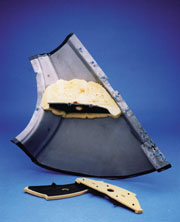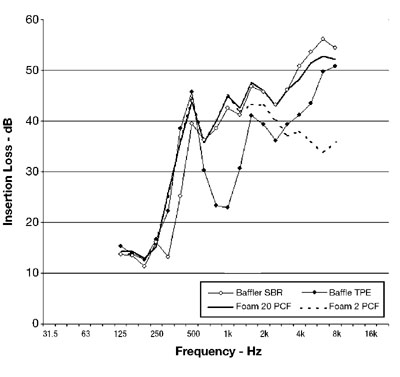Polymers, Elastomers and Two-Component Foams Seal, Reduce Noise Vibration and Harshness, Reduce Vehicle Weight, and Provide Easy Application


- Address issues of noise vibration and harshness (NVH);
- Reduce vehicle weight;
- Improve stiffness;
- Are easy to model, test and validate;
- Lower component/manufacturing costs;
- Are environmentally friendly -- contain recycled material, can be recycled and are safe to handle.

Options for Sealing Hollow-Body Cavities
Most cars are made from a unibody construction where the pillars of the vehicle form an interconnected series of hollow tubes. These hollow tubes or cavities allow air, dust, water, fumes, exhaust and noise to travel freely through the entire vehicle-body structure. Sealants are used to close off these hollow-body cavities to improve HVAC efficiency; help with water management; keep dust, fuel fumes and gas/exhaust vapors from entering the passenger compartment; and improve acoustical performance of the vehicle. Sealants act as a physical barrier to block passage of these things through the cavity. Some materials can also absorb the noise moving through the hollow cavities to improve the acoustical quality of the vehicle.In all cases where sealants are needed, it is critical that the cavity be completely sealed. Significant acoustical and sealing effectiveness can be lost with even a small leak in the seal. A typical four-door car can have 10 different body-cavity areas that need sealants, where an SUV or minivan can have 16 to 20.
Generally, there are three options for sealing cavities: stuffer bags, baffles and foam. Stuffer bags are made up of a polyethylene bag that contains a soft foam block that is literally stuffed into the body cavity during the final assembly. These are a low-cost option for sealing the cavity but do not provide a 100% seal. Because the block must be stuffed into the cavity, it does not fill all the small crevices of the cavity, nor can it be placed in all cavities, since after the space frame is welded together, not all cavities are accessible.
Baffles are made from a reactive formula that is attached to the metal stamping and enclosed inside the cavity during the welding process in the body shop. During the painting and anti-corrosion processes, the vehicle is subjected to bake-oven temperatures and the baffle material expands and cures inside the cavity. (See Figure 1.) Since the baffle materials expand, they can flow and fill small crevices in the cavity, providing a more complete seal than stuffer bags.
The foam used to seal hollow-body cavities is made from a two-component polyurethane that chemically reacts and expands as it is injected into the cavity. (See Figure 2.) The foam is installed just before the car enters the final-assembly phase, and the reaction is complete within seconds of the two components being mixed. In that the foam is injected in as a liquid, it is also able to flow into the small crevices in the cavity, providing a more effective seal than the stuffer bags.

Baffle Technologies
Because there are so many areas in a vehicle that require sealants, Sika Automotive offers a variety of expandable sealants that can be used to fill hollow-body cavities. The baffles are comprised mostly of rubber or plastic materials and expand due to the incorporation of a material that produces nitrogen and carbon dioxide gases when exposed to heat. This produces air pockets inside the material that give the material a foamed appearance. Another material, called a curative, is included to hold the air pockets in place so that they don't collapse or escape.Sika's baffle materials have expansion rates from 50% to over 1,000% by volume. These products are generally non-tacky and can be co-extruded with Sika's high-strength pressure sensitive adhesive. This allows for a secure installation to the oily metals encountered in the body shop. Sika also has thermoplastic baffle materials that are patented, injection moldable and incredibly versatile. They can be used anywhere in the space frame, and the very low water absorption makes thermoplastic materials the sealants of choice when dealing with water-management issues.
Although the materials function in the same way, there are some significant differences between the rubber-based and thermoplastic materials. The thermoplastic materials are injection moldable and have an advantage in that they can be manufactured into complex, three-dimensional shapes. This can allow for easy placement of additional material where it is needed for sealing. They are usually attached to the vehicle with a mechanical fastener using a hole in the sheet metal. The non-blocking nature of these parts allows for bulk packaging and no handling issues.

There are no hard-and-fast rules for sealing hollow-body cavities. For each uniquely shaped cavity, the sealant system is specially designed to maximize acoustical and HVAC performance while minimizing cost and weight. Smaller cavities can be sealed without the need for a metal or nylon carrier. Larger cavities can be sealed with a "racetrack" design that can cut the weight of the part by as much as 40% and the cost as much as 15%.
One of the important benefits of using baffles is that they require no major upfront capital expenditure for inplant material handling or installation equipment. The sealants are generally nontoxic, and no personal protective equipment is needed if proper industrial hygiene practices are followed. Additionally, baffles have no "soft costs" pertaining to installation aids or retaining devices, and are generally a clean process.

Polyurethane Foam Technology
Polyurethane foam, a third option for sealing hollow vehicle cavities, is the end product in the chemical reaction of two components. The two liquid components react quickly to form rigid, closed-cell foam. Component A is the accelerator and Component B is the resin. SikaFoam expands in place to fill and seal cavities as it assumes the shape to the cavity. The density range is 2-30 pounds per cubic foot and the corresponding expansion range is 3,200% to 200%. Depending on the density, it is used for acoustic and/or structural applications. The low-density foam effectively seals the cavity and blocks noise and air leakage.Higher strength rigid foam/higher density foam can provide additional NVH, structural and safety benefits. In addition to blocking the noise and air, higher strength foam (referred to as structural foam) can provide stiffness to hollow-body sections and joints.
During the vehicle assembly, the foam-in-place process is typically performed after the paint processes and before the vehicle begins final trim assembly. A dispensing gun mixes the two components and injects the foam directly into strategic body-cavity locations. The foam requires no outside energy source to react and expand. The foam has excellent adhesion properties when applied to electro-coated or painted surfaces.
Typically, foam is injected into the vehicle cavities late in the paint shop or in the trim shop. Tier 1 suppliers can foam painted subassemblies and ship them to the plant prefoamed. Also, suppliers can apply foam to bare-metal parts if they first remove the lubricants with solvent cleaning.
Today, all OEM applications are done manually, but foam can be robotically applied. With foam, part inventory is dramatically lower than with baffles because only two chemicals are needed for the foam-in-place process. The bulk chemicals are supplied in drums, returnable totes and tank trucks. Foam offers considerable design flexibility. In addition to various densities, shot placement and amount dispensed per shot are easily modified as necessary. Foam can be injected into cavities inaccessible by baffles and cavities created during vehicle assembly.

Measuring Sealant Performance in the Vehicle
Performance of sealant systems in the vehicle is critical. In-vehicle performance can be measured in several ways. Sealing capability of either the baffle or foam systems can be measured using air-loss body-leak equipment. (See Figure 3.) In-vehicle acoustic performance can be measured and sound quality calculated for the total vehicle or individual areas such as pillars, cowls and rockers, etc. Alternatively, materials are tested, and the data is collected and placed into a chart to graphically show acoustical performance. (See Figure 4.)Baffles and foam both play an important role in filling body cavities. For each area of the vehicle, it is necessary to determine which material provides the best sealing and acoustic performance. Currently, both baffles and foam systems are simultaneously used on many vehicles. (See Figure 5.) There is a trend in the industry to increase the use of two-part polyurethane foam because of its performance and cost.
In addition to the wide range of low-cost solutions, Sika Automotive also offers complete development and testing capabilities to automakers. (See Figure 6.) Its new, state-of-the-art Acoustic Test Facility located at its headquarters in Madison Heights allows it to test specific formulations and then validate and optimize their performance under actual operation conditions. A newly built plant in Grandview, Mo., assures that product is manufactured in a timely fashion and that stringent quality is maintained.
Automakers have not been looking for a one-size-fits-all answer to the issues of the 21st century. Sika Automotive presents a model for supplier/partners by providing a menu of options that can serve multiple purposes and still reduce weight and cost.
Additional information on acoustics, bonding and sealing products for the automotive industry is available from Sika Automotive, 30800 Stephenson Highway, Madison Heights, MI 48071; e-mail gapczynski.monica@sika-corp.com or call 248-577-1028. Or Circle No. 73.
Looking for a reprint of this article?
From high-res PDFs to custom plaques, order your copy today!




